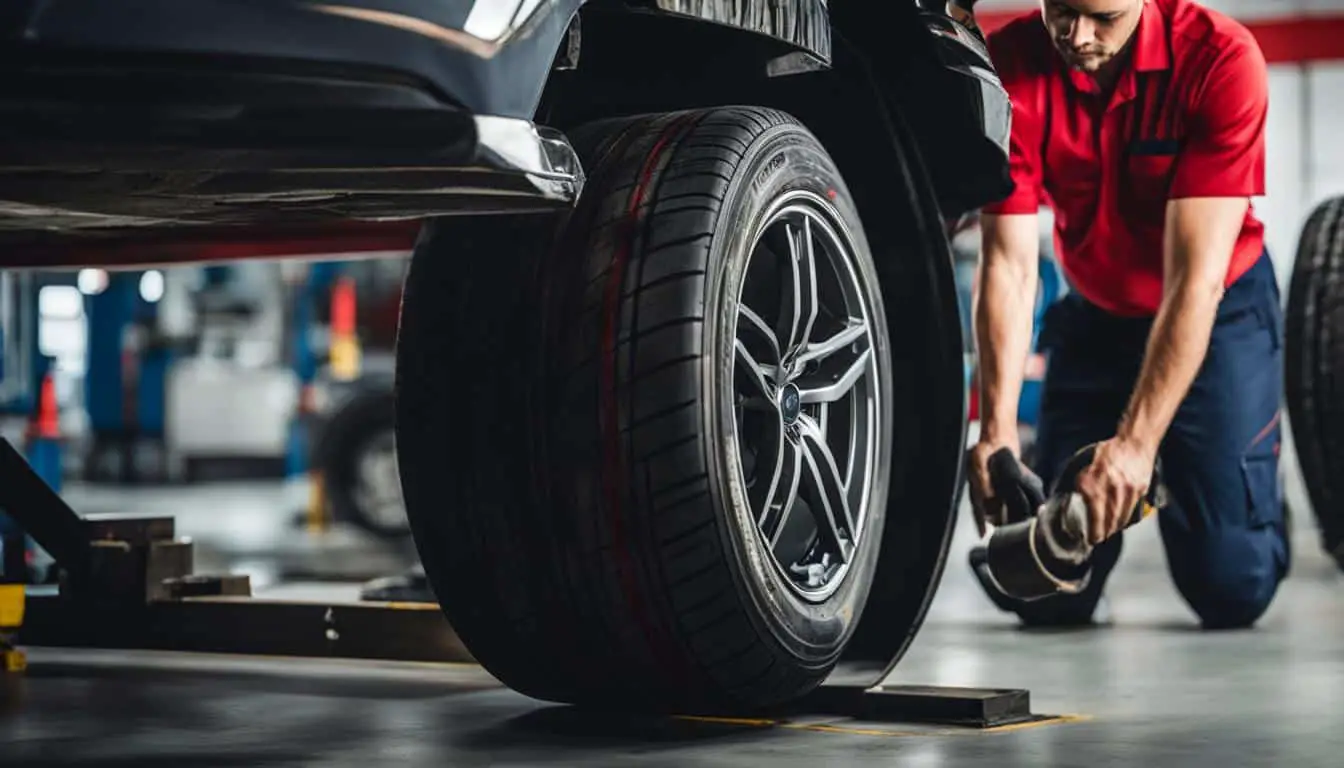
The Art of Balancing and Aligning Car Wheels
As a professional journalist, I know the importance of maintaining a properly functioning vehicle. One crucial aspect of car maintenance is balancing and aligning wheels. When wheels are not balanced or aligned correctly, they can cause unnecessary wear and tear on your tires, leading to a bumpy ride and decreased safety on the road.
Thankfully, professional wheel alignment services can help ensure your car’s wheels are balanced and aligned correctly, improving performance, and safety. In this article, I will discuss the art of balancing and aligning car wheels and why it is vital for maintaining a smooth ride on any road in the US.
Key Takeaways:
- Balancing and aligning car wheels can improve performance and safety.
- Professional wheel alignment services are essential for maintaining a smooth ride.
- Proper car wheel alignment can prevent premature tire wear and uneven tread patterns.
- Regular wheel balancing can extend the lifespan of your tires and improve fuel efficiency.
- Investing in wheel alignment services is a wise decision for the longevity and performance of your vehicle on US roads.
The Process of Wheel Alignment
When it comes to maintaining your vehicle’s performance and safety, regular wheel alignment is essential. A properly aligned car will handle better, give you better gas mileage, and prolong the life of your tires. In this section, I will take you through the process of wheel alignment, its benefits, and the costs involved.
Wheel Alignment Benefits
Proper wheel alignment can provide numerous benefits to both you and your car. Firstly, it reduces the wear and tear on your tires, preventing premature balding and enhancing their longevity. It also improves your gas mileage by reducing the amount of energy it takes to move your car, which means you can save money on fuel in the long run. Additionally, a properly aligned car will handle better, making it easier and safer to drive.
Wheel Alignment Process
The process of wheel alignment involves assessing three different measurements of your car’s wheels: camber, toe, and caster. Camber is the angle of the wheels when viewed from the front, toe is the angle of the wheels when viewed from above, and caster is the angle of the steering pivot when viewed from the side. To adjust these angles, a professional mechanic will use a machine to measure each wheel’s alignment and make adjustments accordingly.
It’s important to note that the process of wheel alignment can differ depending on the type of vehicle you own. For example, a four-wheel alignment is recommended for all-wheel drive and front-wheel drive cars, while a two-wheel alignment is recommended for rear-wheel drive vehicles.
Wheel Alignment Cost
The cost of wheel alignment can vary depending on your location, the type of vehicle you own, and the mechanic you choose. On average, a standard wheel alignment can cost between $75 and $200. However, the cost may increase if additional services are deemed necessary, such as replacing worn-out parts or performing a tire balance.
While the cost of wheel alignment may seem high, it’s important to remember the benefits it provides. Regular wheel alignment can save you money in the long term by reducing tire wear and improving gas mileage, not to mention the increased safety and performance of your vehicle.

In conclusion, investing in proper car wheel alignment is a crucial part of maintaining your vehicle’s safety and performance. By following the wheel alignment process, you can enjoy the benefits of prolonging your tire life, improving gas mileage, and enhancing overall driving experience.
Achieving Perfect Wheel Balancing
Wheel balancing is a crucial aspect of maintaining your vehicle’s optimal performance. It refers to the process of evenly distributing the weight of a tire and wheel assembly to reduce vibrations while driving.
Tire balancing is a crucial factor for preventing premature tire wear, ensuring a smooth driving experience, and improving fuel efficiency, as it reduces unnecessary stress on the steering and suspension systems of your vehicle. A well-balanced wheel provides a more enjoyable driving experience, reducing tire noise and vibration, and promoting better handling and control.
The Wheel Balancing Procedure
The art of wheel balancing is accomplished by using a machine that evaluates the balance of your wheels and tires. The machine then determines where weights are needed to achieve a perfectly balanced wheel. The technician then attaches counterweights to specific areas of the wheel to achieve optimal balance. This process typically takes less than an hour.
Wheel balancing should be done whenever new tires are installed or when the wheels are removed for service. It is also recommended that you have your wheels balanced every 5,000 to 6,000 miles, or if you experience any vibration or shaking while driving.
Benefits of Wheel Balancing
Proper wheel balancing offers several benefits, including:
- Reducing tire vibration for a more comfortable and enjoyable ride
- Minimizing tire wear and extending the lifespan of your tires
- Decreasing stress on your vehicle’s suspension system, improving overall performance and handling
- Increasing fuel efficiency and saving you money on gas
By achieving perfect wheel balancing, you can improve your vehicle’s longevity, save money on repairs, and promote a safer, smoother driving experience.

Conclusion
In conclusion, balancing and aligning car wheels is not just a matter of convenience; it is essential for maintaining the safety and performance of your vehicle. As I have discussed, professional wheel alignment services offer numerous benefits, including improved fuel efficiency, prolonging the lifespan of your tires, and ensuring a comfortable and smooth ride.
However, simply investing in these services is not enough. It is crucial to follow the art of balancing and aligning car wheels by seeking out reputable professionals who can perform the necessary procedures to perfection. By doing so, you can rest assured that your car will handle well in any driving condition, and you can prevent premature tire wear and unpredictable driving behavior.
Ultimately, taking care of your car’s wheels is part of being a responsible driver. Not only does it enhance the longevity of your vehicle, but it also ensures the safety of you and your passengers. Therefore, I urge every driver in the US to invest in professional wheel alignment services and follow the art of balancing and aligning car wheels for a better driving experience.
FAQ
How often should I get my car wheels aligned?
It is recommended to have your car wheels aligned every 6,000 to 10,000 miles or as per your vehicle manufacturer’s guidelines. Regular wheel alignment helps maintain proper tire wear and ensures optimal vehicle performance.
Can wheel alignment fix steering problems?
Yes, wheel alignment can help address steering problems such as pulling to one side, uneven steering response, or a crooked steering wheel. By aligning the wheels, the angles of the tires are adjusted to ensure straight and precise steering.
How can I tell if my wheels are out of balance?
You may notice symptoms like vibrations in the steering wheel or floorboard, uneven tire wear, or a shaking sensation at higher speeds. If you experience any of these signs, it is advisable to have your wheels balanced by a professional.
What are the benefits of wheel balancing?
Wheel balancing helps to distribute the weight evenly across each tire and wheel assembly, reducing vibrations and promoting smoother driving. It benefits your vehicle by improving ride comfort, extending tire life, and preventing premature wear and tear.
How long does wheel alignment take?
The duration of a wheel alignment procedure depends on various factors, such as the type of vehicle and the extent of alignment required. Generally, it takes around 30 minutes to an hour. However, it is recommended to consult with your service provider for a more accurate estimate.
